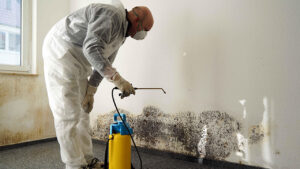Mold Removal Process Osgoode
Storms, fires, and floods may all be terrible and can harm your home. However, the word “mold” really makes homeowners squirm. Why do many individuals fear being sick, not to mention the potential for aesthetic and structural harm? Mold may be dangerous for you, your family, and your employees and has been connected to several health problems. Although it’s not always simple to spot, it can seriously harm your house or place of business over the long run. You must first locate the mold in your home and eliminate it if you think it’s developing there.
On the other hand, you shouldn’t try to do mold treatment on your own. If testing for indoor air quality or an examination reveals that mold levels are excessively high, mold treatment is advised. This should be handled by a reputable remediation business with qualified, trained personnel with expertise in removing and cleaning mold from an interior setting.
A fungus that spreads fast is mold. Humans have been known to experience severe allergic responses to decay, leading to symptoms including rashes, skin and throat irritation, and a general decline in health. Thus, the fungus has to be eliminated as soon as possible. A family house or commercial building may experience water or sewer damage, which can quickly get worse. Furthermore, mold development is more likely if water damage is not adequately dried off. If not thoroughly dried and removed, mold will grow and spread, perhaps posing a health risk to Osgoode residents. The most typical symptoms of mold may resemble allergies or the common cold, but it can also create significant health issues, including infections. Congestion, headaches, and sore throats are all symptoms of mold contamination in your house. Since they are still growing, children are more vulnerable to the adverse effects of fungus. It becomes more challenging to fight mold poisoning as individuals age because their bodies and immune systems deteriorate. Immune systems that are compromised can make people sick. It can be the result of unhealthy lifestyle choices. People who already have respiratory issues like allergies or asthma are especially vulnerable. Even the family dog might become ill from mold in your Osgoode home.

Mold mitigation in Osgoode
Mold eradication is challenging. It needs specialized tools, training, and certification to complete the task correctly. If left untreated, mold may be poisonous and dangerous to one’s health. These factors highlight the need to enlist the aid of a reliable mitigation and restoration firm with skilled staff and the required tools. We are your one-stop shop if you want assistance with mold damage to your house. We can help you identify the cause of the mold damage and execute the best ways to repair your home thanks to our significant expertise in Osgoode. We support our clients and offer the most effective mitigation strategies.
We can address mold issues since we have the expertise, practical experience, and specialized tools. We offer prompt, effective, and complete mold remediation services. We can address mold issues since we have the expertise, practical experience, and specialized tools. We offer prompt, effective, and complete mold remediation services. We choose a Project Manager at the start of the project who will be your primary point of contact all along the way. In addition, if your circumstances call for filing an insurance claim, we will represent you in Osgoode directly with your insurance provider. We perform this daily, although this may be your first time submitting a claim.
Mold removal procedure in Osgoode
You must first locate the mold in your home and eliminate it if you think it’s developing there. On the other hand, you shouldn’t try to do mold treatment on your own. If testing for indoor air quality or an examination reveals that mold levels are excessively high, mold treatment is advised. This should be handled by a reputable remediation business with qualified, trained personnel with expertise in removing and cleaning mold from an interior setting.
Application of antimicrobials
The first step in remedial action is to do this. We can use an antimicrobial solution to stop mold development until the wet area has dried up if your home or business recently sustained water damage, but there is no apparent mold growth. Antimicrobials can eliminate mold spores in the Osgoode area if they are there.
Identification of the source
In places that have previously been exposed to water or that are close to a moisture source, mold is commonly seen. Condensation leads to issues in bathrooms, basements, sink cabinets, and window sills. Our professionals can identify excessive moisture concentrations in residential and commercial properties using cutting-edge, industry-specific moisture detection technologies and inspection methods such as thermal imaging. This typically helps in identifying the moisture intrusion’s source.
Containment
If the correct circumstances are present, mold may spread swiftly. Following the removal of the source of the moisture incursion, our professionals will isolate the afflicted area(s) to prevent mold spores from spreading to other areas of the Osgoode property. Containment is necessary to reduce the possible consequences of cross-contamination in unaffected areas. Containment is required to limit the potential effects of cross-contamination to natural regions.
Filtration of air
During mold eradication, mold spores may be dislodged and release airborne particles. Containment must be combined with air purification. Negative air generators with high-efficiency particle air filters function throughout the project. As a result, mold spores, dirt, bacteria organic compounds, volatile organic compounds, and other airborne debris are removed from the affected region.
Cleaning and removal
In most situations, removing damaged items is the only reliable technique to guarantee successful mold remediation. Materials including plasterboard, insulation, wood trim, carpet, and furniture are typically employed in this procedure. We follow industry guidelines established by the Institute of Inspection Cleaning and Restoration Certification to effectively remove mold from your Osgoode residence or place of business. A certified environmental hygienist’s services are necessary if the mold-contaminated space is more than 10 square feet. The hygienist will conduct a final clearing test to ensure the mold is effectively neutralized.
Replacement
As previously said, infected goods may need removal from mold-infested regions. We may provide restoration services and replace damaged construction components in such circumstances. The property will eventually be restored to its pre-loss state.
Precautions to avoid mold in your Osgoode home
After learning how to confiscate mold, focus on avoiding it. The worst influxes often begin in moist crawl spaces, attics, walls where outside water seeps in, and basements with inadequate material drainage. The most excellent mold prevention techniques are stopping leaks, ensuring sufficient attic ventilation, maintaining dry crawl spaces, and diverting water from the foundation. In humid spaces like toilets and non-airy areas outside, surface mold can be treated with mildewcide in paint. Mildewcide is already included in many colors. Find out more about mold removal solutions at your neighborhood paint store close to Osgoode.
Determine the Problem Areas in Your House and Fix Them:
Your home cannot be made mold-proof, but you may make it mold-resistant. Conduct a house audit: What are the problem areas? Is the basement flooded? Do you regularly notice the dampness on an upstairs window? Is there a leak that keeps happening that has left a stain on the ceiling?
It may be as easy as tearing out carpet in a wet basement, setting up mold-resistant goods, or fixing broken gutters to stop mold from developing or spreading. Or, it could require significant excavation and waterproofing. Whatever the matter may be, take action right now. It could be expensive initially, but it will undoubtedly increase if mold spreads unchecked.
Dry Wet Areas Right Away:
Mold cannot form without moisture, so dry up wet areas immediately. A spill on the carpet, water seepage into the basement after heavy rain, or accumulation from a leaking pipe must be dried within 24 to 48 hours. If you’ve suffered a flood, remove any water-damaged furniture, bedding, or carpets that can’t be burnt. Even everyday tasks demand attention: properly dry the floor and walls after a shower and avoid leaving moist items lying about the house. Mold may quickly spread in the washer if damp clothes are dumped there. Dry them by hanging them up, ideally outside or in a place with sufficient airflow.
Proper Ventilation Can Prevent Moisture:
Mold growth is aided by the everyday duties you undertake around the house. Cooking, showering, and doing laundry are all activities that might attract mold, so make sure your washroom, kitchen, laundry room, and any other high-moisture space have adequate ventilation. Appliances that produce moisture, including stoves and washing dryers, should be vented outside rather than into the attic. Use dehumidifiers and air conditioners (especially in humid areas), but inspect and maintain them as the manufacturer directs to prevent them from generating moisture on their own. When cooking, cleaning the dishes, or having a shower, open a window or switch on an exhaust fan since your energy-efficient home can retain moisture inside.
Provide Mold-Resistant Products in Your Home:
Should I build a new house or remodel an existing one? Use mold-resistant plasterboard or Sheetrock, mold-resistant paints, and other mold-resistant materials. A gypsum plaster core is pressed between layers of paper to create a traditional plasterboard. Plasterboard that resists mold is paperless; the gypsum core is coated in fiberglass, greatly enhancing the surface’s water resistance. Bathrooms, laundry rooms, basements, and kitchens are among spaces that benefit significantly from moisture-resistant plasterboard. In addition to being more prone to mold than paperless plasterboard, traditional plasterboard is also more difficult to remove and more expensive to repair. There is also a plasterboard that is resistant to mold development; the core of the plasterboard is constructed to prevent moisture absorption and, consequently, mold formation.
Monitor Humidity Indoors:
The EPA recommends 30 to 60% humidity for interior spaces. Use a moisture meter from the hardware store down the street to measure humidity. Additionally, you might find excessive humidity levels in your home by concentrating on potential issue places. A high humidity level is present when there is condensation on walls, pipes, or windows. If you notice condensation, dry the area immediately and address the moisture issue (for example, turn off your humidifier if you see water within nearby windows).
Keep the water flowing away from your house:
Water may accumulate near your home’s foundation if the surrounding earth isn’t appropriately sloped away from it, allowing it to seep into your crawlspace or basement.
